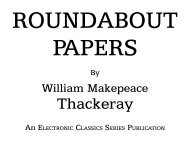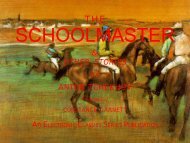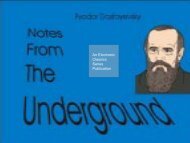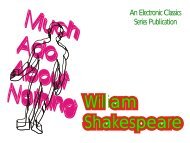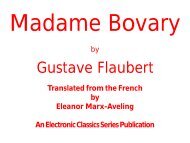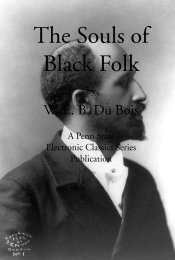- Page 1 and 2:
A Tale ale of Two wo Cities by Char
- Page 3 and 4:
A Tale of Two Cities by Charles Dic
- Page 5 and 6:
A Tale of Two Cities - Dickens of L
- Page 7 and 8:
A Tale of Two Cities - Dickens ing
- Page 9 and 10:
A Tale of Two Cities - Dickens (“
- Page 11 and 12:
A Tale of Two Cities - Dickens III
- Page 13 and 14:
A Tale of Two Cities - Dickens diml
- Page 15 and 16:
A Tale of Two Cities - Dickens clea
- Page 17 and 18:
A Tale of Two Cities - Dickens “Y
- Page 19 and 20:
A Tale of Two Cities - Dickens cloa
- Page 21 and 22:
A Tale of Two Cities - Dickens busi
- Page 23 and 24:
A Tale of Two Cities - Dickens “A
- Page 25 and 26:
A Tale of Two Cities - Dickens Lorr
- Page 27 and 28:
A Tale of Two Cities - Dickens in i
- Page 29 and 30:
A Tale of Two Cities - Dickens The
- Page 31 and 32:
A Tale of Two Cities - Dickens the
- Page 33 and 34:
A Tale of Two Cities - Dickens “Y
- Page 35 and 36:
A Tale of Two Cities - Dickens “I
- Page 37 and 38:
A Tale of Two Cities - Dickens tifu
- Page 39 and 40:
A Tale of Two Cities - Dickens the
- Page 41 and 42:
A Tale of Two Cities - Dickens lips
- Page 43 and 44:
A Tale of Two Cities - Dickens She
- Page 45 and 46:
A Tale of Two Cities - Dickens draw
- Page 47 and 48:
A Tale of Two Cities - Dickens Book
- Page 49 and 50:
A Tale of Two Cities - Dickens and
- Page 51 and 52:
A Tale of Two Cities - Dickens with
- Page 53 and 54:
A Tale of Two Cities - Dickens II A
- Page 55 and 56:
A Tale of Two Cities - Dickens thro
- Page 57 and 58:
A Tale of Two Cities - Dickens eral
- Page 59 and 60:
A Tale of Two Cities - Dickens III
- Page 61 and 62:
A Tale of Two Cities - Dickens too
- Page 63 and 64:
A Tale of Two Cities - Dickens “S
- Page 65 and 66:
A Tale of Two Cities - Dickens “N
- Page 67 and 68:
A Tale of Two Cities - Dickens fami
- Page 69 and 70:
A Tale of Two Cities - Dickens pris
- Page 71 and 72:
A Tale of Two Cities - Dickens “I
- Page 73 and 74:
A Tale of Two Cities - Dickens “I
- Page 75 and 76:
A Tale of Two Cities - Dickens appe
- Page 77 and 78:
A Tale of Two Cities - Dickens said
- Page 79 and 80:
A Tale of Two Cities - Dickens “O
- Page 81 and 82:
A Tale of Two Cities - Dickens With
- Page 83 and 84:
A Tale of Two Cities - Dickens frui
- Page 85 and 86:
A Tale of Two Cities - Dickens “M
- Page 87 and 88:
A Tale of Two Cities - Dickens “D
- Page 89 and 90:
A Tale of Two Cities - Dickens cove
- Page 91 and 92:
A Tale of Two Cities - Dickens seco
- Page 93 and 94:
A Tale of Two Cities - Dickens The
- Page 95 and 96:
A Tale of Two Cities - Dickens supp
- Page 97 and 98:
A Tale of Two Cities - Dickens eart
- Page 99 and 100:
A Tale of Two Cities - Dickens abje
- Page 101 and 102:
A Tale of Two Cities - Dickens The
- Page 103 and 104:
A Tale of Two Cities - Dickens VIII
- Page 105 and 106:
A Tale of Two Cities - Dickens “P
- Page 107 and 108:
A Tale of Two Cities - Dickens She
- Page 109 and 110:
A Tale of Two Cities - Dickens A su
- Page 111 and 112:
A Tale of Two Cities - Dickens “B
- Page 113 and 114:
A Tale of Two Cities - Dickens “M
- Page 115 and 116:
A Tale of Two Cities - Dickens sens
- Page 117 and 118:
A Tale of Two Cities - Dickens with
- Page 119 and 120:
A Tale of Two Cities - Dickens ters
- Page 121 and 122:
A Tale of Two Cities - Dickens Ther
- Page 123 and 124:
A Tale of Two Cities - Dickens He l
- Page 125 and 126:
A Tale of Two Cities - Dickens so s
- Page 127 and 128:
A Tale of Two Cities - Dickens want
- Page 129 and 130:
A Tale of Two Cities - Dickens “Y
- Page 131 and 132:
A Tale of Two Cities - Dickens Stry
- Page 133 and 134:
A Tale of Two Cities - Dickens The
- Page 135 and 136:
A Tale of Two Cities - Dickens hour
- Page 137 and 138:
A Tale of Two Cities - Dickens hims
- Page 139 and 140:
A Tale of Two Cities - Dickens even
- Page 141 and 142:
A Tale of Two Cities - Dickens have
- Page 143 and 144:
A Tale of Two Cities - Dickens ing,
- Page 145 and 146:
A Tale of Two Cities - Dickens flop
- Page 147 and 148:
A Tale of Two Cities - Dickens men,
- Page 149 and 150:
A Tale of Two Cities - Dickens “Y
- Page 151 and 152:
A Tale of Two Cities - Dickens Notw
- Page 153 and 154:
A Tale of Two Cities - Dickens Agai
- Page 155 and 156:
A Tale of Two Cities - Dickens the
- Page 157 and 158:
A Tale of Two Cities - Dickens “A
- Page 159 and 160:
A Tale of Two Cities - Dickens of h
- Page 161 and 162:
A Tale of Two Cities - Dickens XVI
- Page 163 and 164:
A Tale of Two Cities - Dickens own,
- Page 165 and 166:
A Tale of Two Cities - Dickens in t
- Page 167 and 168:
A Tale of Two Cities - Dickens find
- Page 169 and 170:
A Tale of Two Cities - Dickens “O
- Page 171 and 172:
A Tale of Two Cities - Dickens thun
- Page 173 and 174:
A Tale of Two Cities - Dickens thar
- Page 175 and 176:
A Tale of Two Cities - Dickens him.
- Page 177 and 178:
A Tale of Two Cities - Dickens them
- Page 179 and 180:
A Tale of Two Cities - Dickens half
- Page 181 and 182:
A Tale of Two Cities - Dickens that
- Page 183 and 184:
A Tale of Two Cities - Dickens that
- Page 185 and 186:
A Tale of Two Cities - Dickens were
- Page 187 and 188:
A Tale of Two Cities - Dickens “T
- Page 189 and 190:
A Tale of Two Cities - Dickens XX A
- Page 191 and 192:
A Tale of Two Cities - Dickens When
- Page 193 and 194:
A Tale of Two Cities - Dickens That
- Page 195 and 196:
A Tale of Two Cities - Dickens had
- Page 197 and 198:
A Tale of Two Cities - Dickens thro
- Page 199 and 200:
A Tale of Two Cities - Dickens Ther
- Page 201 and 202:
A Tale of Two Cities - Dickens “H
- Page 203 and 204:
A Tale of Two Cities - Dickens head
- Page 205 and 206:
A Tale of Two Cities - Dickens were
- Page 207 and 208:
A Tale of Two Cities - Dickens ster
- Page 209 and 210:
A Tale of Two Cities - Dickens a vi
- Page 211 and 212:
A Tale of Two Cities - Dickens very
- Page 213 and 214:
A Tale of Two Cities - Dickens sold
- Page 215 and 216:
A Tale of Two Cities - Dickens XXIV
- Page 217 and 218:
A Tale of Two Cities - Dickens the
- Page 219 and 220:
A Tale of Two Cities - Dickens itse
- Page 221 and 222:
A Tale of Two Cities - Dickens men,
- Page 223 and 224:
A Tale of Two Cities - Dickens thes
- Page 225 and 226:
A Tale of Two Cities - Dickens “H
- Page 227 and 228:
A Tale of Two Cities - Dickens Noth
- Page 229 and 230:
A Tale of Two Cities - Dickens the
- Page 231 and 232:
A Tale of Two Cities - Dickens of t
- Page 233 and 234:
A Tale of Two Cities - Dickens and
- Page 235 and 236:
A Tale of Two Cities - Dickens the
- Page 237 and 238:
A Tale of Two Cities - Dickens II T
- Page 239 and 240:
A Tale of Two Cities - Dickens The
- Page 241 and 242:
A Tale of Two Cities - Dickens eous
- Page 243 and 244:
A Tale of Two Cities - Dickens III
- Page 245 and 246:
A Tale of Two Cities - Dickens litt
- Page 247 and 248:
A Tale of Two Cities - Dickens and
- Page 249 and 250:
A Tale of Two Cities - Dickens cut
- Page 251 and 252:
A Tale of Two Cities - Dickens corn
- Page 253 and 254:
A Tale of Two Cities - Dickens her
- Page 255 and 256:
A Tale of Two Cities - Dickens head
- Page 257 and 258:
A Tale of Two Cities - Dickens the
- Page 259 and 260:
A Tale of Two Cities - Dickens alre
- Page 261 and 262:
A Tale of Two Cities - Dickens True
- Page 263 and 264:
A Tale of Two Cities - Dickens rush
- Page 265 and 266:
A Tale of Two Cities - Dickens shar
- Page 267 and 268:
A Tale of Two Cities - Dickens head
- Page 269 and 270:
A Tale of Two Cities - Dickens The
- Page 271 and 272:
A Tale of Two Cities - Dickens Pros
- Page 273 and 274:
A Tale of Two Cities - Dickens of L
- Page 275 and 276:
A Tale of Two Cities - Dickens that
- Page 277 and 278:
A Tale of Two Cities - Dickens and
- Page 279 and 280:
A Tale of Two Cities - Dickens rema
- Page 281 and 282:
A Tale of Two Cities - Dickens turn
- Page 283 and 284:
A Tale of Two Cities - Dickens not
- Page 285 and 286:
A Tale of Two Cities - Dickens note
- Page 287 and 288:
A Tale of Two Cities - Dickens plai
- Page 289 and 290:
A Tale of Two Cities - Dickens ligh
- Page 291 and 292: A Tale of Two Cities - Dickens publ
- Page 293 and 294: A Tale of Two Cities - Dickens X Th
- Page 295 and 296: A Tale of Two Cities - Dickens We a
- Page 297 and 298: A Tale of Two Cities - Dickens dead
- Page 299 and 300: A Tale of Two Cities - Dickens plun
- Page 301 and 302: A Tale of Two Cities - Dickens brot
- Page 303 and 304: A Tale of Two Cities - Dickens youn
- Page 305 and 306: A Tale of Two Cities - Dickens * *
- Page 307 and 308: A Tale of Two Cities - Dickens wild
- Page 309 and 310: A Tale of Two Cities - Dickens and
- Page 311 and 312: A Tale of Two Cities - Dickens XII
- Page 313 and 314: A Tale of Two Cities - Dickens “E
- Page 315 and 316: A Tale of Two Cities - Dickens turn
- Page 317 and 318: A Tale of Two Cities - Dickens Now,
- Page 319 and 320: A Tale of Two Cities - Dickens ing
- Page 321 and 322: A Tale of Two Cities - Dickens to h
- Page 323 and 324: A Tale of Two Cities - Dickens the
- Page 325 and 326: A Tale of Two Cities - Dickens the
- Page 327 and 328: A Tale of Two Cities - Dickens went
- Page 329 and 330: A Tale of Two Cities - Dickens hand
- Page 331 and 332: A Tale of Two Cities - Dickens poss
- Page 333 and 334: A Tale of Two Cities - Dickens came
- Page 335 and 336: A Tale of Two Cities - Dickens Seei
- Page 337 and 338: A Tale of Two Cities - Dickens “N
- Page 339 and 340: A Tale of Two Cities - Dickens expl
- Page 341: A Tale of Two Cities - Dickens By g
- Page 345 and 346: A Tale of Two Cities - Dickens The
- Page 347: A Tale of Two Cities - Dickens “I




